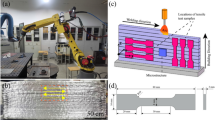Abstract
A novel additive manufacturing method with TIG–MIG hybrid heat source was applied for fabricating 5356 aluminum alloy component. In this paper the microstructure evolution, mechanical properties and fracture morphologies of both as-deposited and heat-treated component were investigated, and how these were affected by different heat-treated temperature. The as-deposited microstructure showed dominant equiaxed grains with second phase, and the size of them is coarse in the bottom region, medium in the middle region and fine in the top region owing to different thermal cycling conditions. Compared with as-deposited microstructure, the size of grain becomes large and second phases gradually dissolve in the matrix as heat-treated temperature increase. Different microstructures determine the mechanical properties of component. Results show that average ultimate tensile strength enhances from 226 to 270 MPa and average microhardness increases from 64.2 to 75.3 HV0.1 but ductility decreases from 33 to 6.5% with heat-treated temperature increasing. For all components, the tensile properties are almost the same in the vertical direction (Z) and horizontal direction (Y) due to equiaxed grains, which exhibits isotropy, and the mechanisms of these are analyzed in detailed. In general, the results demonstrate that hybrid arc heat source has the potential to fabricate aluminum alloy component.











Similar content being viewed by others
References
M. Ruffo, C. Tuck, R.J.M. Hague, Cost estimation for rapid manufacturing: laser sintering production for low to medium volumes. Proc. Inst. Mech. Eng. Part B J. Eng. Manuf. 220, 1417–1427 (2006)
S.H. Huang, P. Liu, A. Mokasdar, L. Hou, Additive manufacturing and its societal impact: a literature review. Int. J. Adv. Manuf. Technol. 67, 1191–1203 (2013)
K.V. Wong, A. Hernandez, A review of additive manufacturing. ISRN Mech. Eng. 2, 1–10 (2012)
M.H. Farshidianfar, A. Khajepour, A.P. Gerlich, Effect of real-time cooling rate on microstructure in Laser Additive Manufacturing. J. Mater. Process. Technol. 231, 468–478 (2016)
C.A. Brice, B.T. Rosenberger, S.N. Sankaran et al., Chemistry control in electron beam deposited titanium alloys. Mater. Sci. Forum 618, 155–158 (2009)
Y. Ma, D. Cuiuri, N. Hoye et al., The effect of location on the microstructure and mechanical properties of titanium aluminides produced by additive layer manufacturing using in situ alloying and gas tungsten arc welding. Mater. Sci. Eng. A 631, 230–240 (2015)
F. Martina, J. Mehnen, S.W. Williams et al., Investigation of the benefits of plasma deposition for the additive layer manufacture of Ti–6Al–4V. J. Mater. Process. Technol. 212, 1377–1386 (2012)
E. Brandl, A. Schoberth, C. Leyens, Morphology, microstructure, and hardness of titanium (Ti–6Al–4V) blocks deposited by wire-feed additive layer manufacturing (ALM). Mater. Sci. Eng. A 532, 295–307 (2012)
J.Y. Bai, C.L. Fan, S.B. Lin et al., Effects of thermal cycles on microstructure evolution of 2219-Al during GTA-additive manufacturing. Int. J. Adv. Manuf. Technol. 87, 1–9 (2016)
J.Y. Bai, C.L. Yang, S.B. Lin et al., Mechanical properties of 2219-Al components produced by additive manufacturing with TIG. Int. J. Adv. Manuf. Technol. 86, 1–7 (2015)
J.Y. Bai, C.L. Fan, S.B. Lin et al., Mechanical properties and fracture behaviors of GTA-additive manufactured 2219-Al after an especial heat treatment. J. Mater. Eng. Perform. 26, 1808–1816 (2017)
J. Gu, J. Ding, S.W. Williams et al., The effect of inter-layer cold working and post-deposition heat treatment on porosity in additively manufactured aluminum alloys. J. Mater. Process. Technol. 230, 26–34 (2016)
J. Gu, J. Ding, S.W. Williams et al., The strengthening effect of inter-layer cold working and post-deposition heat treatment on the additively manufactured Al–6.3Cu alloy. Mater. Sci. Eng. A 651, 18–26 (2016)
H. Geng, J. Xiong, D. Huang et al., A prediction model of layer geometrical size in wire and arc additive manufacture using response surface methodology. Int. J. Adv. Manuf. Technol. 2015, 1–12 (2015)
A.S. Haselhuhn, B. Wijnen, G.C. Anzalone et al., In situ formation of substrate release mechanisms for gas metal arc weld metal 3-D printing. J. Mater. Process. Technol. 226, 50–59 (2015)
H. Geng, J. Li, J. Xiong et al., Optimisation of interpass temperature and heat input for wire and arc additive manufacturing 5A06 aluminium alloy. Sci. Technol. Weld Join 2016, 1–12 (2016)
A.S. Haselhuhn, M.W. Buhr, B. Wijnen et al., Structure–property relationships of common aluminum weld alloys utilized as feedstock for GMAW-based 3-D metal printing. Mater. Sci. Eng. A 673, 511–523 (2016)
H. Geng, J. Li, J. Xiong et al., Geometric limitation and tensile properties of wire and arc additive manufacturing 5A06 aluminum alloy parts. J. Mater. Eng. Perform. 26, 1–9 (2016)
C. Zhang, Y. Li, M. Gao et al., Wire arc additive manufacturing of Al–6Mg alloy using variable polarity cold metal transfer arc as power source. Mater. Sci. Eng. A 711, 415–423 (2018)
S. Zhou, Z. Zhang, M. Li et al., Effect of Sc on microstructure and mechanical properties of as-cast Al–Mg alloys. Mater. Des. 90(6), 1077–1084 (2016)
J.D. Ming, W.C. Li, Y.U. Jie et al., Cleavage and intergranular fracture in Al–Mg alloys. Mater. Sci. Technol. 49, 387–392 (2002)
N.K. Babu, K. Kallip, M. Leparoux et al., Influence of microstructure and strengthening mechanism of AlMg5–Al2O3, nanocomposites prepared via spark plasma sintering. Mater. Des. 95, 534–544 (2016)
Øyvind Ryen, B. Holmedal, O. Nijs et al., Strengthening mechanisms in solid solution aluminum alloys. Metall. Mater. Trans. A 37, 1999–2006 (2006)
E.L. Huskins, B. Cao, K.T. Ramesh, Strengthening mechanisms in an Al–Mg alloy. Mater. Sci. Eng. A 527, 1292–1298 (2010)
M. Zha, X.T. Meng, H.M. Zhang et al., High strength and ductile high solid solution Al-Mg alloy processed by a novel hard-plate rolling route. J. Alloys Compd. 728, 872–877 (2017)
Acknowledgements
This work was supported by National Natural Science Foundation of China (Nos. 51305291 and 51505040) and Natural Science Foundation of Shanxi Province (Nos. 201701D121075 and 201302121-1).
Author information
Authors and Affiliations
Corresponding author
Rights and permissions
About this article
Cite this article
Zuo, W., Ma, L., Lu, Y. et al. Effects of Solution Treatment Temperatures on Microstructure and Mechanical Properties of TIG–MIG Hybrid Arc Additive Manufactured 5356 Aluminum Alloy. Met. Mater. Int. 24, 1346–1358 (2018). https://doi.org/10.1007/s12540-018-0142-3
Received:
Accepted:
Published:
Issue Date:
DOI: https://doi.org/10.1007/s12540-018-0142-3




